Need a plant that is colorful yet simple and is low maintenance? You will find anything that you look for in a house plant in this gorgeous plant, Tradescantia nanouk! The Nanuok variety just happens to be colorful, attractive, and, more importantly, easy to care for and cultivate. It is one of the favorite indoor plants of many collectors because of its beauty and ease of care. Not to mention its huge, luxuriant leaves with green, pink, and white stripes and attractive little white and yellow flowers emerging from pink buds!
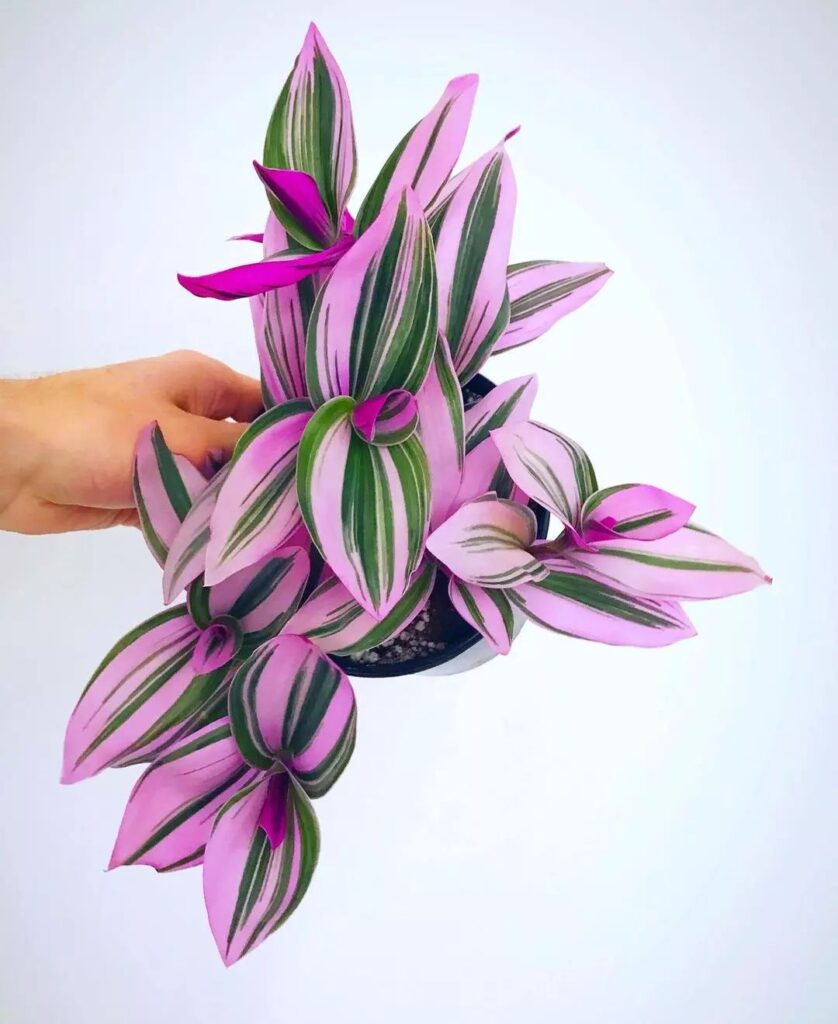
If you decide to purchase these plants for your own care or if someone has already gifted one rare specimen to you, then you’re definitely going to need a bit of time learning all about this plant.
Below is some necessary information for caring for your Tradescantia Nanuok, including growing conditions, propagation, troubleshooting common problems, and keeping their captivating colors!
Tradescantia Nanouk Profile
General Information
Tradescantia nanouk, also known as Fantasy Venice, is a spiderwort plant variety that has grown popular among plant enthusiasts. The Nanouk is a variety developed by cross-pollinating seedlings of the plant parent Tradescantia albiflora in 2012. The development of this patented plant was made near Sappemeer, in the Netherlands.
The trendy plant is gaining rounds inside the social media sphere because of its gorgeous bright green, purple, and pink leaves that are fuzzy and growing on thick stems. The Nanuok cultivar has been developed to be fairly full, with a trailing and an upright spreading habit.
Tradescantia Nanouk is classed as a “rare” houseplant since it is difficult to find in some areas, but it is not as tough to find as you may think because it is available in most plant stores. This plant is also a fast-growing plant. The common names of this variety include Fantasy Venice, Spiderwort Nanouk, Nanouk, Wandering Jew, and Inch Plant.
The characteristics that set the Nanuok distinct among other Tradescantia plants include:
- compact and erect spreading habit
- healthy and strong foliage
- Green, light purple, and grayish-green leaves
- Strong interiorscape performance
The Tradescantia plants originated from the tropical forests of Central and South America.
Etymology
The genus Tradescantia was named after the two English naturalists and explorers, John Tradescant the Elder and John Tradescant the Younger. This is to honor their contribution to botany for their introduction of many plants to English gardens.
The variety name, Nanouk, may come from the Inuit word Nanuq, which means polar bear.
Flowering
Under the right conditions, Tradescantia Nanouk will flower during the growing season. It flowers when given enough sunlight, either bright indirect sunlight or direct sunlight. Flowers produce more when exposed to indirect bright light. The flowers that are produced are small and star-shaped with white, yellow, and pink highlights.
Season of Interest and Purchasing
This plant grows actively during the spring and summer. Hence, you may want to purchase this plant during those times so you can supplement it with the right food and requirements.
Growth
Nanouk Tradescantia is considered a quick grower if given the right growth conditions. The plant typically grows to a height and width of just about three and a half inches. It has a highly compact and upright growth habit and spreads readily.
RELATED: 12 Types of Popular Tradescantia Wandering Jew Plants With Pictures
Tradescantia Nanuok Overview
| Scientific name | Tradescantia albiflora ‘Nanuok’ |
| Common name/s | Fantasy Venice, Spiderwort Nanouk, Nanouk, Wandering Jew |
| Family | Commelinaceae |
| Growth Habit | Herbaceous |
| Height and Spread | height about 8.9 cm, spread about 8.6 cm. |
| Classification based on life cycle | Perennial |
| Origin and Distribution | Developed in the Netherlands |
| Climate Zone | Generally mild climate |
| USDA Plant Hardiness Zone | USDA Zone 10-12 |
| Color | Variable stripes of light pink, green, and greyish green |
Care Tips
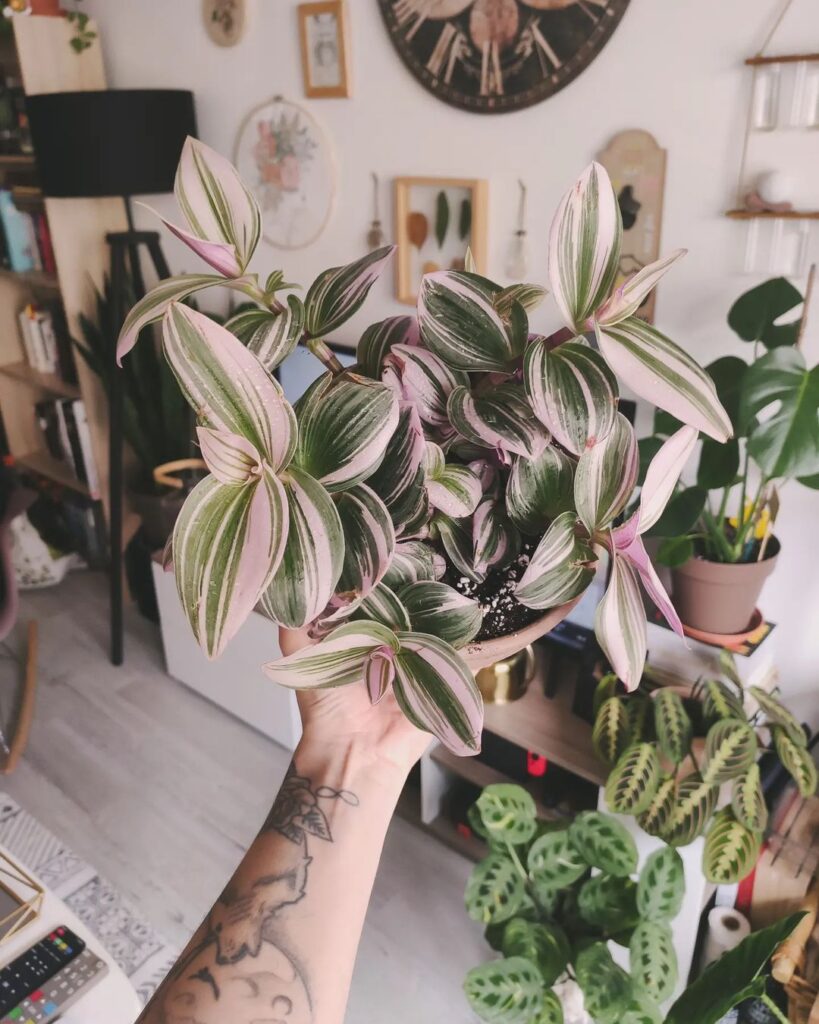
Light Requirement
Tradescantia nanouk thrives in bright, indirect light. Your plant will thrive if you position it in a north-or east-facing window. Indirect bright light promotes blooming formation as well. Avoid too much light, especially bright, direct light, over lengthy periods of time since it may cause the leaves to become crispy.
On the other hand, placing your Tradescantia in an area with little light will cause the foliage to fade.
Temperature Requirement
The Tradescantia plants love warmer environments. They thrive best on temperatures between 75°F (24°C) and 54°F (12°C). However, the plant can still flourish at temperatures as low as 54°F (12°C). The Nanouk can also thrive indoors in normal household temperatures.
Summer and spring are the best seasons for this plant. On the other hand, late fall and winter’s cold, frigid season slows its growth. If at all possible, relocate them to a warmer room with adequate lighting.
Water Requirement
Watering your Tradescantia Nanuok is relatively easy. When the top inch of soil is dry, then it’s the time for you to water your Tradescantia nanouk. It’s best to do it every three days, but once a week would do. The bottom line is it all depends on your location and the amount of light your plants receive.
In general, it is essential for this plant to keep the soil moist but not overwatered. Overwatering might lead to root rot, which we do not want to happen to your plants. By watering at the right time, you’ll keep your plant happy.
Humidity Requirement
Tradescantia Nanouk has thicker leaves that are less sensitive in terms of humidity. For these plants, average home humidity is usually enough. However, it will grow best in a humid environment, so putting it in a room with a bit more humidity is best.
During the dry winter months, you may need to provide an extra boost of humidity. It can be helped by misting it frequently, placing it near a humidifier, or using a pebble tray.
Soil Requirement
To keep your plant healthy, use a houseplant potting mix that includes orchid bark, perlite, and a small amount of horticultural sand. It’s essential to use a pH of 5.5 to 6.5 in a regular well-draining houseplant soil or well-aerated soil mix. A thick soil can lead to root rot and a variety of other issues.
Fertilizer Requirement
A fertilizing schedule is essential to stick to since your Nanuok, with its colorful variegation, is necessarily working overtime to photosynthesize. Hence, they will need the extra help they can get as this will support their growth and health.
It is not a heavy feeder, so a balanced fertilizer (20-20-20) is enough. You can dilute this to 50% in order to avoid root burn. Aside from liquid fertilizer, you can also use slow-release plant foods as well as this will evenly distribute the dose across weeks. In its growing season, apply fertilizer every 6 to 8 weeks and reduce this frequency during winter.
Do note that overfertilization can also harm your Tradescantia Nanuok as it is sensitive to mineral build-up. Therefore, avoid cheap fertilizers and avoid overfertilization to mitigate this problem.
Space Requirement
The Tradescantia ‘Nanouk’, being small, does not need much space to grow. However, it grows quickly. It may grow over a foot each year in a good climate. These plants are compact, having stems that can either grow up or trail out. Since it will trail a few feet, try placing it in a hanging basket or planter on top of an elevated side table.
RELATED: Alocasia wentii: The #1 Care, Watering, And Propagation Guide
Growing And Planting Tips

Propagation
Tradescantia nanouk is quite simple to grow. It can be grown in water or directly in the soil.
Tradescantia Nanouk Propagation By Division
There are several different stems in Tradescantia nanouk. Remove the plant from its container and carefully separate the roots. Do this with caution. Your plants may experience some stress after being separated and repotted.
Here’s how it’s done:
- Cut below a node on a stem with a few leaves with a pair of clean, sharp scissors.
- Plant your cutting in wet soil, with at least one node below the surface.
- As the roots grow, keep the soil damp but not soggy.
- It should be exposed to bright, indirect light.
- After a few weeks, you may evaluate your cut by gently tugging on it.
Tradescantia Nanouk Propagation By Stem
Stem cuttings can also be used to grow Tradescantia nanouk. Take a stem cutting that is a few inches long and remove the leaves from the bottom to propagate them in water.
Here’s how it’s done:
- Cut below a node on a stem with a few leaves with a pair of clean, sharp scissors.
- Place the cutting in a container that has water, making sure that at least one node is submerged.
- Place the container in an area with bright, indirect light.
- After about a week, you should notice little roots emerging.
- Wait until the roots have grown large enough to transplant your stem.
Nanouk stems may be propagated directly into the soil using the same cutting method. Then, in well-drained soil, plant the cuttings. To keep the soil wetter, water it a little more than you would for your new plant.
Pruning
Since Tradescantia nanouk is a vigorous grower, it may require regular pruning. First, cut the stem slightly above the node and leaf to encourage new growth. This means the node and leaf will remain attached to the plant. It also fosters bushy growth and branching by removing decaying leaves. This will make the plant fuller and reduce legginess.
Potting And Repotting
This plant grows quickly, so it’s good to repot it several times. Repotting your Tradescantia is best done during the growing season. During the winter, these plants are dormant. It is not a good idea to utilize them when they are dormant.
These plants don’t like wet roots. Use a container with drainage holes that don’t hold too much moisture. Then the new pot should be 1-2 inches bigger and deeper than the one you’re using now.
Here’s how it’s done:
- Select an appropriate container.
- Give the parent plants plenty of water. This will make it easier to separate the roots without hurting them.
- Pull the vines of your Tradescantia nanouk gently.
- Fill your new container with well-drained soil and place the plant at the bottom.
- Water your plants well.
- Place your Tradescantia nanouk in a well-ventilated, indirect-light area.
Tradescantia Nanuok Care
| Light | Bright indirect light |
| Temperature | Intermediate to warm, 54-75 degrees Fahrenheit |
| Water | Once a week, increased in summer, decreased in winter |
| Soil | Airy, well-draining soil; phH of 5.5 to 6.5 |
| Fertilization | Regular household fertilizer, once a month |
| Space | Less space required |
| Propagation | Via division and stem propagation |
| Blooming | Enough sunlight and maturity needed |
| Pruning | Regular pruning |
| Potting | Regular potting mix, use of orchid bark, perlite, and horticultural sand |
RELATED: Maranta Lemon Lime: An Easy To Follow Care, Propagation, And Watering Guide
Problems And Troubleshooting
Overwatering
The proper combination of moist and dry soil is ideal for Tradescantia Nanouk. They don’t like being completely dry, and they also don’t like being overwatered. Always check the soil. Allow the soil to dry up before watering again totally. Overwatering can result in yellowing foliage, fungal diseases, root rot, and fungus gnat problems. Prevention is better than cure.
Underwatering
Your Tradescantia nanouk will suffer if they go too long without water. Brown and crispy leaf margins are common signs of underwatering. On the other hand, these plants are drought-tolerant, preferring to be submerged rather than overwatered. If your plant is suffering from underwatering, give it some moisture immediately. They will eventually recover.
Nutrient Deficiency
Any essential nutrient deficiency can cause harm, and in the worst-case situation, it will die. It can also cause leaf color loss. To minimize issues caused by nutrient insufficiency, be sure to give your plant enough light, a frequent watering schedule, and feed it with a well-balanced fertilizer.
Flowering Problems
These plants will not blossom indoors unless there is enough light. Therefore, it’s likely to bloom outside. The Tradescantia Nanouk will blossom during the growing season if the conditions are favorable. Though blossoming isn’t the primary reason for this plant’s popularity, its variegated leaves are more attractive and beautiful.
Pests
The most common pests of the Nanuok are spider mites and scales. They suck the sap of your plant and can cause damage. Mites may be harder to spot while scales are more visible. Once you spot these pests, you can spray them with the insecticidal soap of your choice. This might take 3 to 4 weeks to resolve. Another option is neem oil.
Tradescantia Nanuok Pests and Diseases
| Common Pests/Diseases | Symptoms | Treatment and Prevention |
Common diseases include crown rot, stem rot, root rot, leaf spot, fungal diseases, and Xanthomonas infection | Yellowish rimming around black or dark brown spots on leaves | Avoid overwatering. Keep soil dry. Avoid too high humidity.Proper ventilation is needed around the plant. Remove infected parts of fungal infections to avoid spreading |
Common pests include mealybugs, spider mites, aphids, and scales | Visible insects on the surface | Spray plant with warm, soapy water. If infestation is present, use insecticide or neem oil. Use diatomaceous earth. |
Problems With People And Animals
Toxicity
All types of Tradescantia, including Tradescantia Nanouk, are poisonous. It is harmful or toxic to children, adults, and pets. If consumed, the sap of all Tradescantia species can irritate the skin and induce gastrointestinal upset. So keep it out of reach of your pets and children.
Tradescantia Plants Meaning And Symbolism
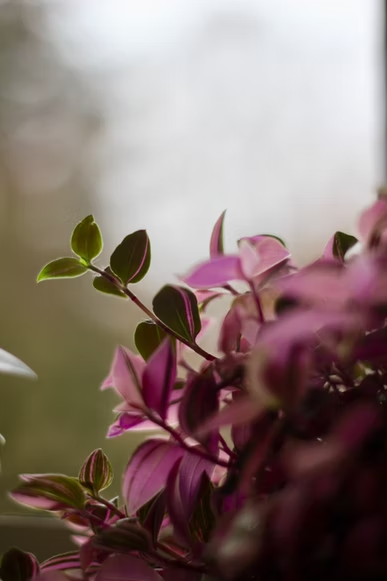
Tradescantia represents longevity, hope, and moral power. The myth of Tradescantia is based on its Middle Ages appellation, “the Wandering Jew.” The idea of immortality refers to the fact that this houseplant is highly hopeful and, if properly cared for, will actually roam all over the place.
| General Meaning | Longevity, hope, and moral power |
| Symbolism | Immortality |
| Cultural Significance | Wandering Jew |
Landscaping And Gardening Ideas
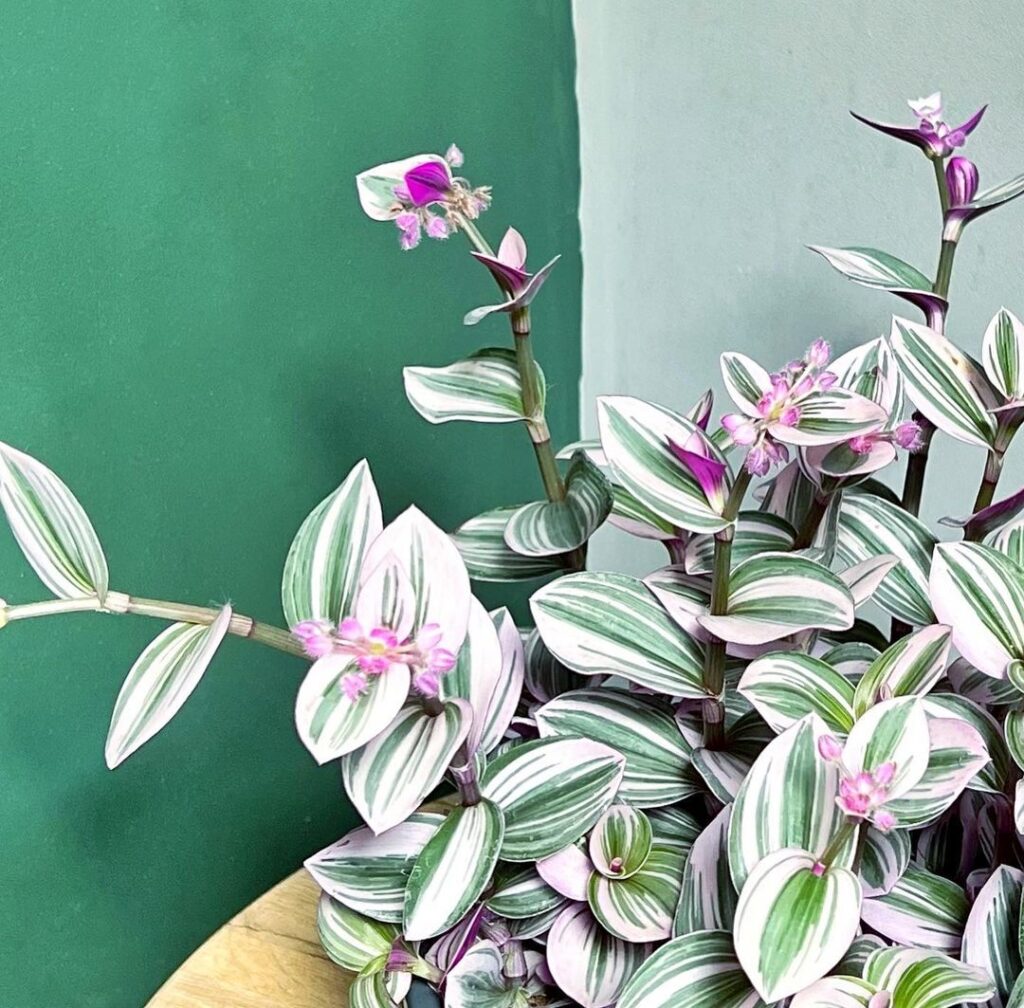
Companion Plants
This plant was formed to be colorful, appealing, and simple to cultivate. This plant is an excellent companion to many other plants because of its gorgeous leaves and little blooms. It goes well with the Tricolor oyster plant, which has similar variegation but a distinct plant form, or with Purple Pixie Loropetalum and Asian Jasmine in your garden.
Landscaping Ideas
This beautiful Tradescantia Nanouk should be part of your home or garden collection. The huge leaves have green and (light) pink stripes. This plant will look great in your all-green indoor jungle.
It’s commonly used as a ground cover because of its vibrant leaves. However, this plant may be cultivated inside by placing it in a hanging basket or exhibiting it. Place your Tradescantia Nanouk near a window that gets plenty of light.
| What to plant with | Tricolor Oyster Plant, Purple Pixie Loropetalum, Asian Jasmine |
| What NOT to plant with | Basically nothing |
Conclusion
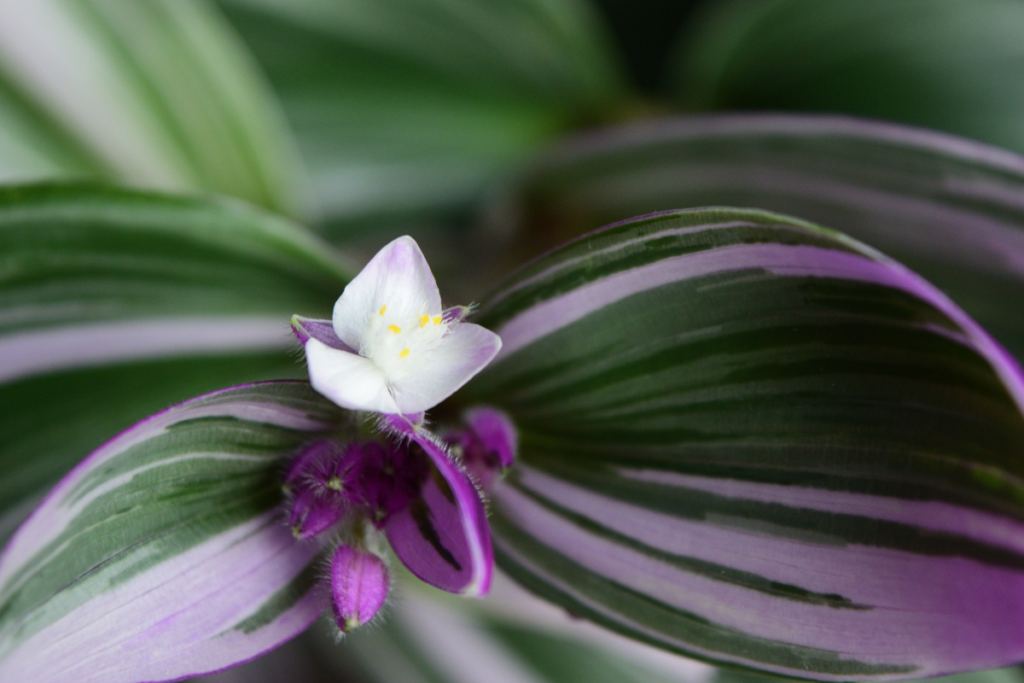
The Tradescantia ‘Nanouk’ or Spiderwort’ Nanouk’ is definitely a must-have in your plant collection. The lovely pink, green, and white lance-shaped leaves are enough for you to consider getting this plant. The tiny, three-petaled blooms that come in blue, pink-purple, or white will surely make your space vibrant. These plants will stand out if you incorporate them in all of your green gardens.
Tradescantia’ Nanouk,’ like most other species of the genus developed for indoor cultivation, is easy to care for and a vigorous grower, and its trailing growth pattern makes it an excellent choice.
Frequently Asked Questions
- Why is my Tradescantia Nanuok turning green?
The light greatly influences the coloration of the leaves the plant is receiving. That is why the position of the plant is very important, especially for multi-colored plants like your Nanuok. If your Nanuok does not receive ample light or is left in the dark for too long, the stems are more likely to be leggy and stretched, and the leaves will turn green and lose their variegations.
- How do I make my Tradescantia Nanuok fuller?
To make your Nanuok lush and fuller, give it the appropriate amount of care and attention. Make sure you provide the correct amount and quality of light, humidity, water, soil type, and fertilizer. Repotting your plant is also necessary, especially when it is already rootbound.
- Is Tradescantia Nanuok a rare plant?
The Nanuok variety of Tradescantia is somewhat a rare plant. Although, with the advent of tissue culture cultivation and mass propagation, the plant’s availability in the market has improved.
- Is Tradescantia Nanuok hard to grow?
Definitely not. Tradescantias are relatively easy to grow and care for. They can thrive in a suitable room condition provided that the optimum care and attention are given. Beginners can definitely grow this plant.
- How do I get my Tradescantia to flower?
In order for your plant to bloom, it must receive enough light. This is because the genes responsible for flowering are light-activated; hence, when light is insufficient, these genes will not be activated and will not induce your plant to flower.
Editor’s Recommendations
Pothos Vs. Philodendron: How To Tell Between The Two Popular Houseplants?
Monstera albo: The Best Care, Propagation, And Watering Guide
Rhaphidophora tetrasperma: The Complete Care, Watering, And Propagation Guide







